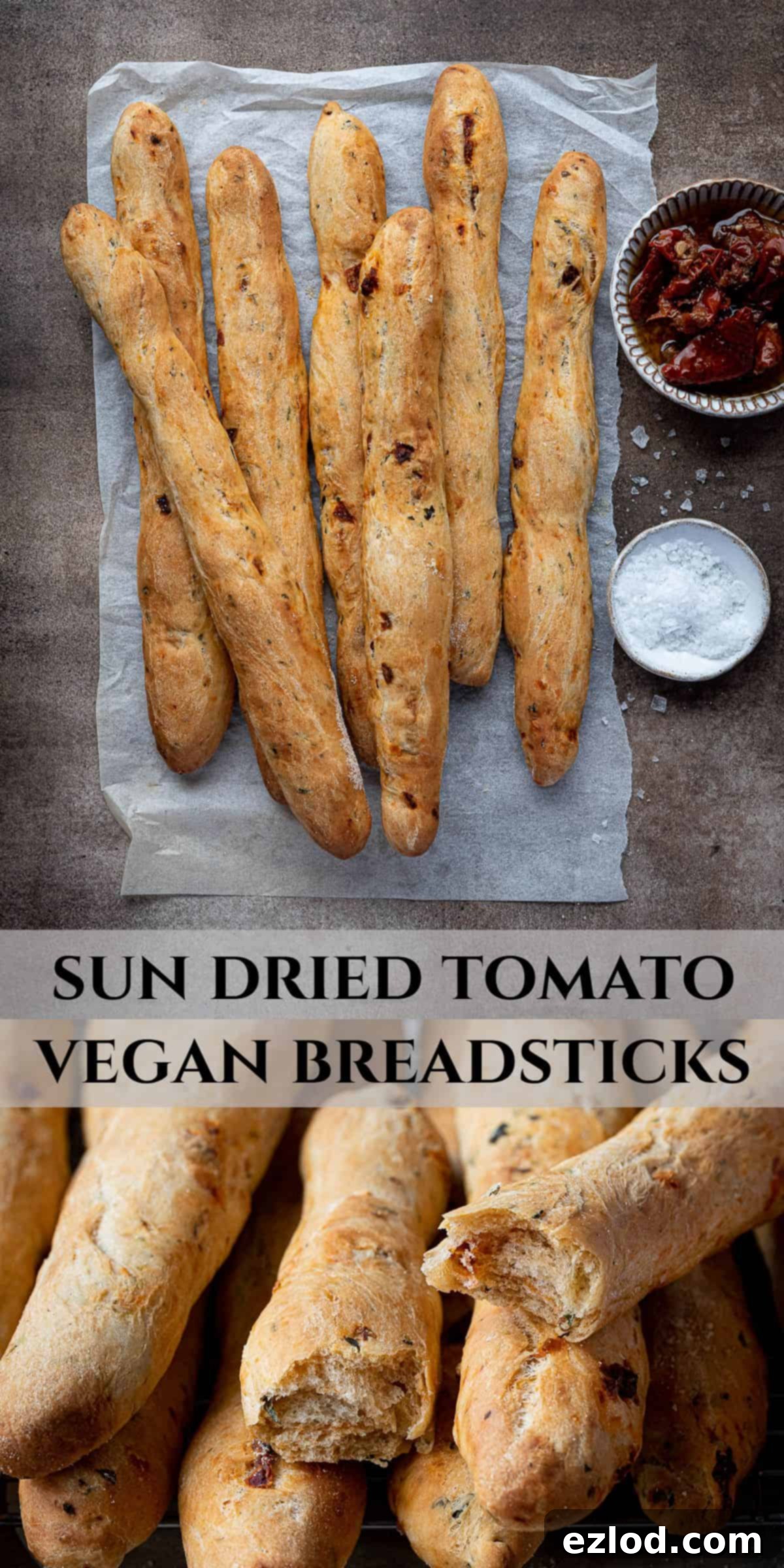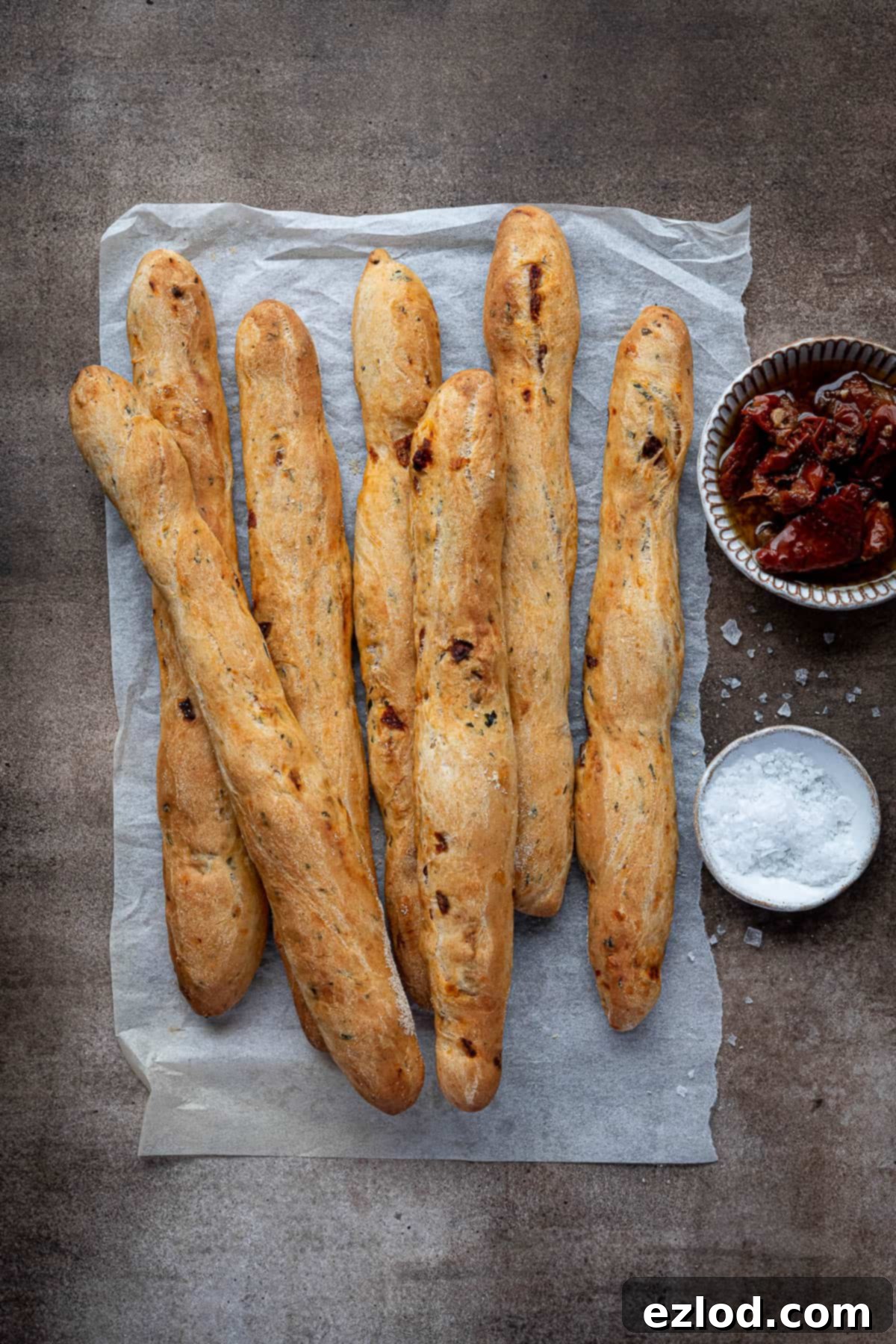Delicious Vegan Sun-Dried Tomato & Basil Breadsticks: Soft, Chewy, and Easy to Make
Welcome to the delightful world of homemade breadsticks! These easy vegan sun-dried tomato and basil breadsticks are a true culinary treat. Renowned for their irresistible softness and satisfyingly chewy texture, they are incredibly simple to make and versatile enough to complement a wide array of dishes. Whether you’re looking for the perfect accompaniment for your favorite dips, a hearty soup, or a flavorful alternative to traditional dinner rolls, these homemade breadsticks are guaranteed to impress. Infused with the rich, intense flavor of sun-dried tomatoes and the fragrant freshness of basil, they offer a gourmet experience right in your own kitchen.
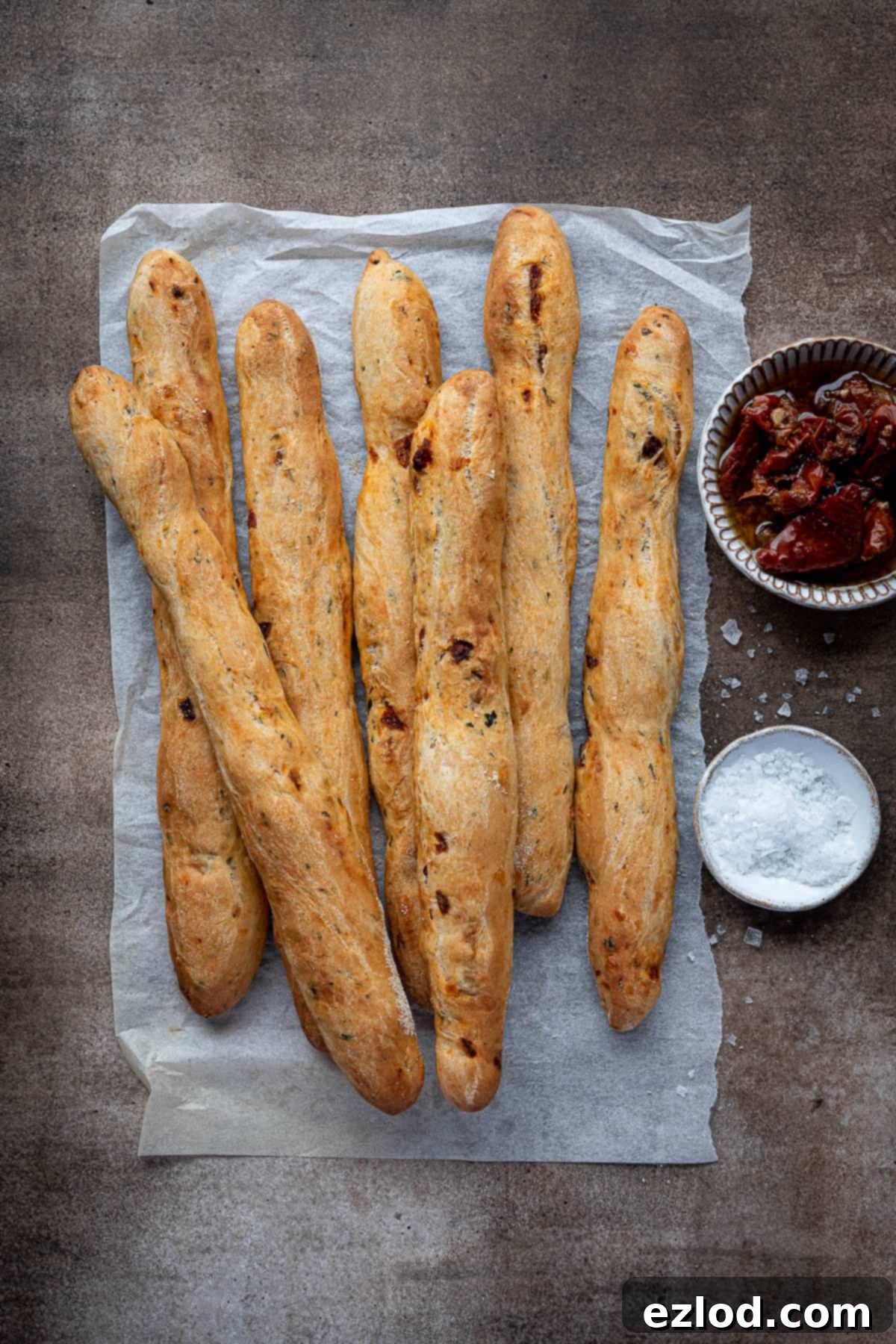
Imagine warm, freshly baked breadsticks emerging from your oven, filling your home with an aroma that promises pure comfort. These sun-dried tomato breadsticks deliver exactly that – a perfect balance of deliciously soft interior, a pleasantly chewy texture, and a subtly crisp crust. The vibrant flavors of sweet sun-dried tomatoes and aromatic fresh basil are woven throughout the dough, making each bite an explosion of Mediterranean taste. While they are exceptional when served alongside a creamy dip, a robust soup, or a fresh salad, their incredible flavor often means they’re enjoyed just as they are, straight off the baking sheet!
This fantastic recipe builds upon my highly adaptable herby vegan breadsticks base. It’s a testament to how easily a simple dough can be transformed into a myriad of different delicious flavors! This particular iteration, featuring the delightful combination of sun-dried tomatoes and basil, is a fan favorite for good reason. It’s an approachable recipe, even for those new to baking bread, offering a rewarding experience with minimal fuss and yielding consistently delicious results that taste far more complex than the effort required.
Why You’ll Adore These Vegan Sun-Dried Tomato & Basil Breadsticks
Beyond being incredibly delicious, these breadsticks offer several compelling reasons to make them a staple in your recipe repertoire. They are:
- Completely Vegan: Crafted entirely from plant-based ingredients, these breadsticks are perfect for anyone following a vegan lifestyle or simply looking to incorporate more delicious plant-based options into their meals.
- Soft & Chewy Perfection: The carefully balanced dough recipe ensures an ideal texture – tender and yielding on the inside, with a satisfying chewiness that makes them incredibly moreish and addictive.
- Bursting with Mediterranean Flavor: The rich, tangy essence of sun-dried tomatoes, combined with the fragrant, slightly peppery notes of fresh basil, creates a sophisticated and vibrant flavor profile. Each breadstick is a little taste of the Mediterranean.
- Surprisingly Easy to Make: With clear, step-by-step instructions and readily available pantry staples, this recipe is accessible for bakers of all skill levels. You don’t need to be a bread-making expert to achieve fantastic results with these homemade breadsticks.
- Incredibly Versatile: These tomato and basil breadsticks are perfect for almost any occasion. Serve them as an elegant appetizer, a flavorful side dish with your favorite Italian meal, a wholesome snack, or even a replacement for dinner rolls. They pair beautifully with a variety of dips, soups, and salads.
- Homemade Goodness at Its Best: There’s truly nothing quite like the taste and comforting aroma of freshly baked bread. Making these at home allows you to control the quality of ingredients and enjoy a warm, wholesome, and utterly delicious treat straight from your oven.
Essential Ingredients for Your Perfect Sun-Dried Tomato Breadsticks:
Crafting perfect, soft, and chewy breadsticks starts with understanding the role of each ingredient. Here’s a detailed look at what you’ll need and why:
- Bread Flour: This is arguably the most crucial component for achieving that desirable fluffy and delightfully chewy breadstick texture. Bread flour has a higher protein content (typically 12-14%) compared to all-purpose (plain) flour. This higher protein level means more gluten can develop, providing the essential structure and elasticity needed for a robust and airy crumb. While plain flour will work if that’s all you have, your breadsticks may turn out slightly less chewy and more cake-like. I strongly advise against using wholemeal (whole wheat) flour, as its higher fiber content and coarser texture will result in a much denser, heavier breadstick, rather than the light and airy texture we are aiming for.
- Instant Yeast: My top choice for bread baking due to its incredible convenience, instant yeast (sometimes labeled “easy bake yeast” or “fast-acting yeast”) consists of smaller granules that dissolve and activate quickly. This means you can mix it directly into your dry ingredients without the need for prior activation in liquid, which saves time and simplifies the overall process. I highly recommend using instant yeast whenever possible for a hassle-free baking experience. If you only have active dry yeast, don’t worry – I’ve included specific instructions below on how to properly activate it to ensure your dough rises beautifully.
- Olive Oil: A touch of quality olive oil in the dough serves multiple purposes. It significantly contributes to the breadsticks’ delightful softness and adds a subtle, pleasant Mediterranean flavor. For the best results, opt for a mild olive oil rather than extra virgin, which can sometimes be too strong or impart a slightly bitter note when baked at high temperatures. Any other neutral-flavored oil, such as canola, sunflower, or grapeseed oil, can also be substituted if preferred. Additionally, brushing the shaped breadsticks with olive oil before baking creates a beautifully crisp, golden, and aromatic crust that truly elevates the finished product. If you prefer an alternative wash, you can use a plant-based milk or aquafaba (the liquid from a can of chickpeas), or brush them with melted non-dairy butter immediately after baking for a rich, glossy finish.
- Salt: A non-negotiable ingredient in any good bread recipe, salt is absolutely vital for several reasons. It dramatically enhances the overall flavor, preventing the breadsticks from tasting bland. Furthermore, salt plays a critical role in controlling yeast activity, slowing down fermentation just enough for optimal flavor development and strengthening the gluten structure, which contributes to the dough’s elasticity and rise. Do not be tempted to omit it.
- Sugar: Just a small amount – typically a teaspoon – is all that’s needed. This modest addition provides a readily available food source for the yeast, which helps kickstart the fermentation process and encourages a robust and consistent rise in the dough. It doesn’t make the breadsticks sweet, but rather aids in their development, contributes to a better crust color, and balances the savory flavors.
- Sun-Dried Tomatoes: For this specific recipe, it’s essential to use sun-dried tomatoes that are packed in oil, not the completely dry, leathery kind. The oil-packed variety are already rehydrated and much softer, ensuring they blend seamlessly into the dough and provide a concentrated burst of sweet, tangy tomato flavor and a lovely, yielding texture. Remember to drain them very well and pat them thoroughly dry with kitchen paper before chopping to avoid introducing excess moisture into your dough, which could alter its consistency.
- Fresh Basil: Fresh basil leaves are paramount for achieving the vibrant, aromatic, and truly authentic flavor that defines these breadsticks. Their sweet, peppery, and slightly anise-like notes complement the intense sun-dried tomatoes perfectly, creating a classic flavor pairing. While fresh is undeniably best, if you absolutely cannot find it, you could experiment with a very small amount of dried basil (use about ⅓ of the fresh amount), but be aware the flavor will be significantly less intense and lack the brightness. Feel free to experiment with other fresh herbs like oregano or rosemary if you want to vary the flavor profile, but fresh basil is truly the star here for that classic taste.
- Semolina or Cornmeal (Optional): This optional, but highly recommended, addition is a secret weapon for achieving a professional-quality crust. By lightly sprinkling your baking sheets with some fine semolina or cornmeal before placing the shaped breadsticks, you create a slightly gritty barrier. This prevents the dough from sticking to the parchment, and more importantly, encourages a wonderfully crisp, golden-brown bottom crust on your breadsticks. It adds a subtle textural contrast that is a delight to bite into.
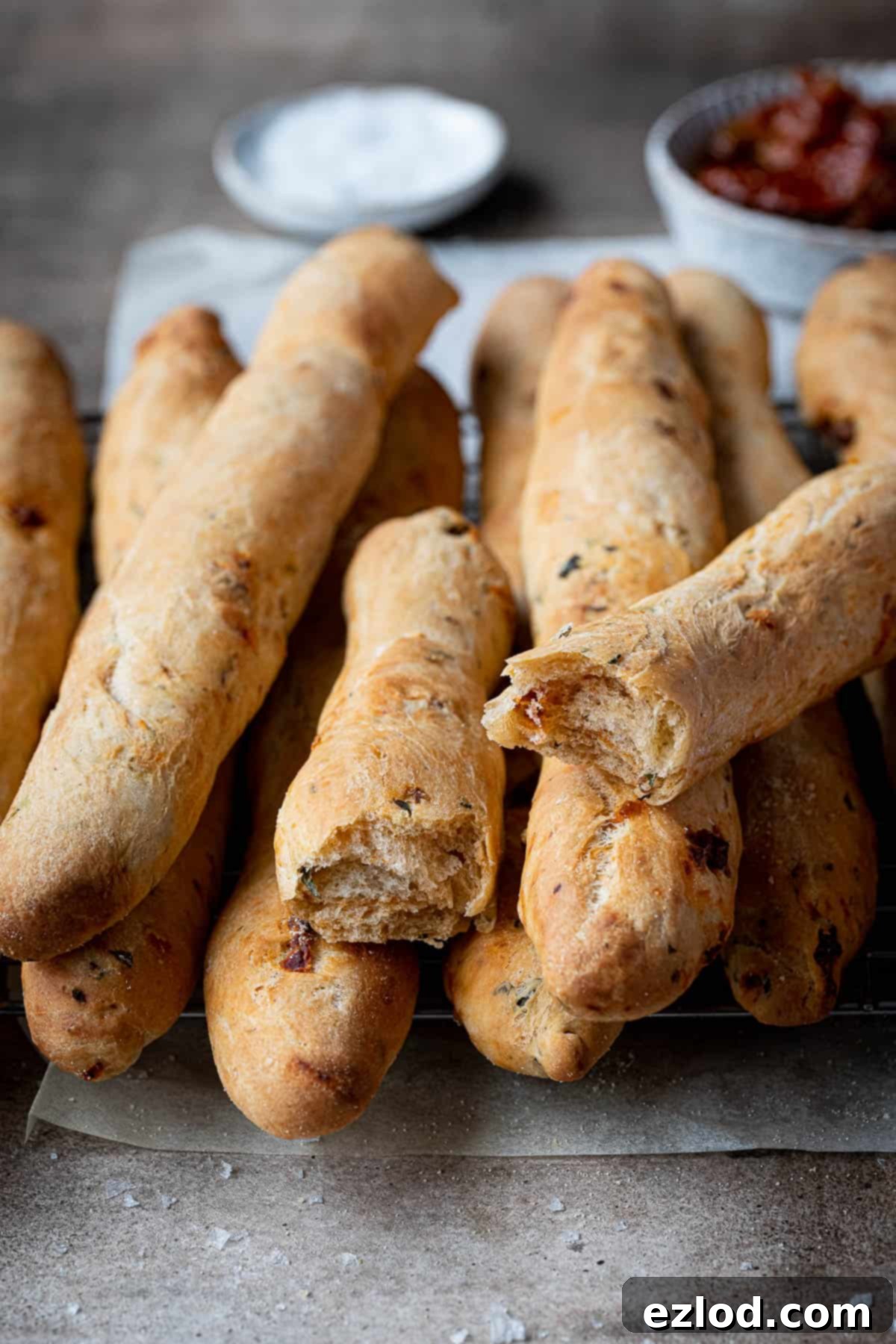
Step-by-Step Guide: How to Make Irresistible Sun-Dried Tomato Breadsticks:
(For precise measurements and detailed instructions, please refer to the comprehensive recipe card located at the bottom of this page.)
Making these flavorful breadsticks is a wonderfully rewarding process that even novice bakers can master. Follow these clear steps for perfect, golden-brown results every time:
- Prepare the Dry Ingredients: Begin by placing the bread flour into a large mixing bowl. If you are using a stand mixer, attach the dough hook to the mixer. Carefully add the instant yeast to one side of the bowl and the salt and sugar to the opposite side. This initial separation is important to prevent the salt from directly contacting the yeast, which can inhibit its activity. Give all the dry ingredients a quick stir with a spoon or your hand to combine them lightly.
- Introduce Wet Ingredients and Form a Rough Dough: Now, pour in the olive oil and the lukewarm water into the bowl with the dry ingredients. Using your hands or the stand mixer on a low speed, mix all the ingredients together until they just come together to form a shaggy, rough dough. At this stage, it won’t look smooth or uniform, but all the flour should be hydrated and no dry pockets should remain.

- Knead for Smoothness and Elasticity: Turn the rough dough out onto a clean, lightly floured surface (or continue kneading with the stand mixer on a medium/high speed). Knead the dough vigorously for approximately 5-10 minutes. If kneading by hand, use the heel of your hand to push the dough away from you, then fold it back over itself, rotating the dough slightly after each push. You’re aiming for the dough to transform from sticky and shaggy into a smooth, elastic, and pliable mass. It should feel slightly tacky to the touch but should pull away cleanly from your hands or the sides of the mixing bowl. If it feels excessively wet, you can add a tiny bit more flour, but remember that a slightly sticky dough is often a sign of good hydration and will result in a more tender breadstick.
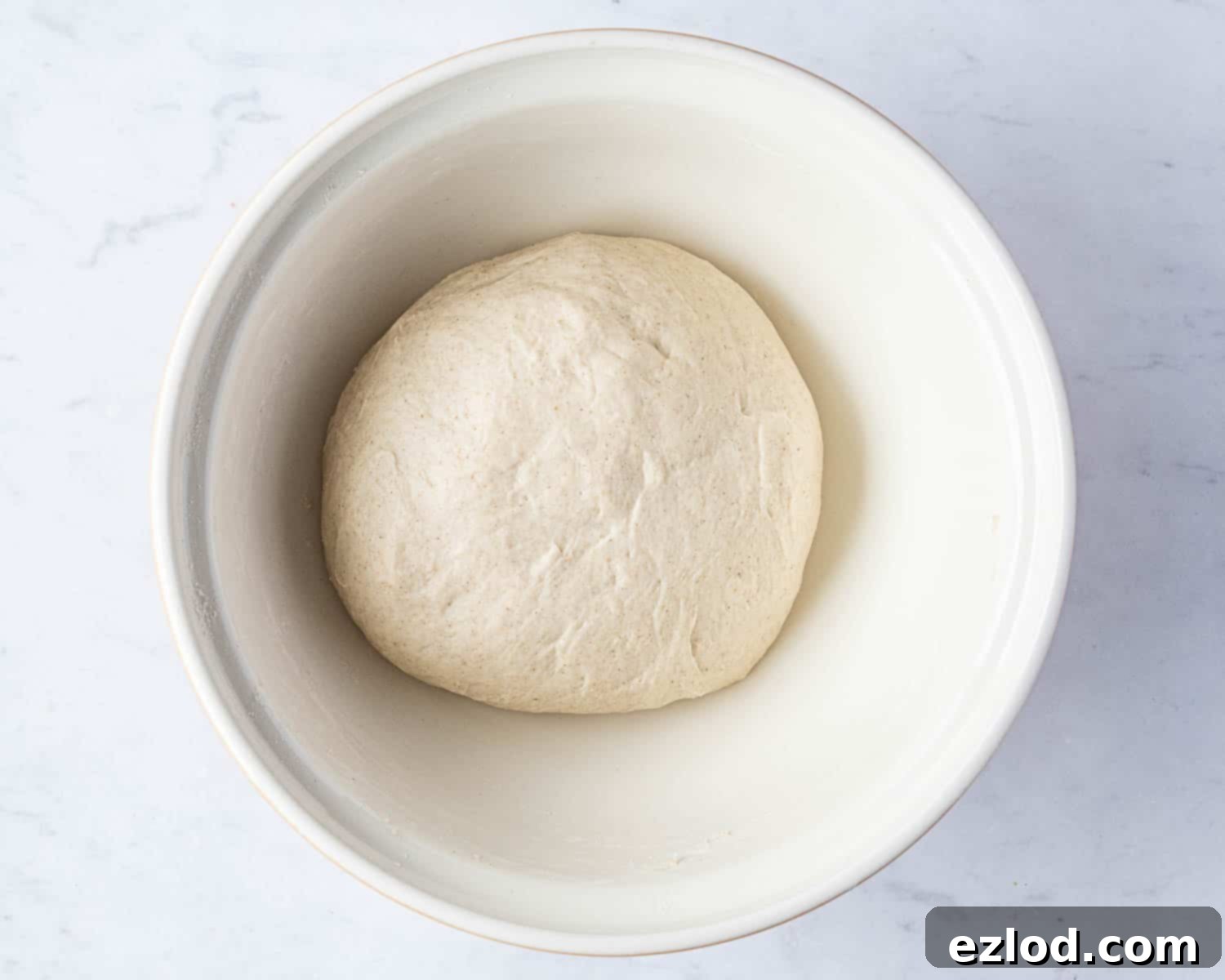
- Incorporate the Flavorful Additions: Take your oil-packed sun-dried tomatoes and thoroughly dry them with kitchen paper to remove any excess oil – this step is crucial to prevent the dough from becoming too greasy or wet. Then, chop the dried tomatoes into small, even pieces. Finely chop your fresh basil leaves. Add these vibrant additions to the kneaded dough and continue to knead for another 1-2 minutes until they are thoroughly and evenly distributed throughout the dough. If the tomatoes add too much moisture, you can dust with a tiny bit more flour, being careful not to overdo it.
- First Rise (Bulk Fermentation): Lightly oil a clean, large bowl. Place the dough into the oiled bowl, turning it once to ensure all sides are lightly coated with oil. This prevents it from sticking. Cover the bowl loosely with plastic wrap or a damp kitchen towel to create a humid environment. Set it aside in a warm, draft-free place to rise until it has visibly doubled in size. This process typically takes about 1-2 hours, but the exact time will depend on your room temperature and the activity of your yeast.
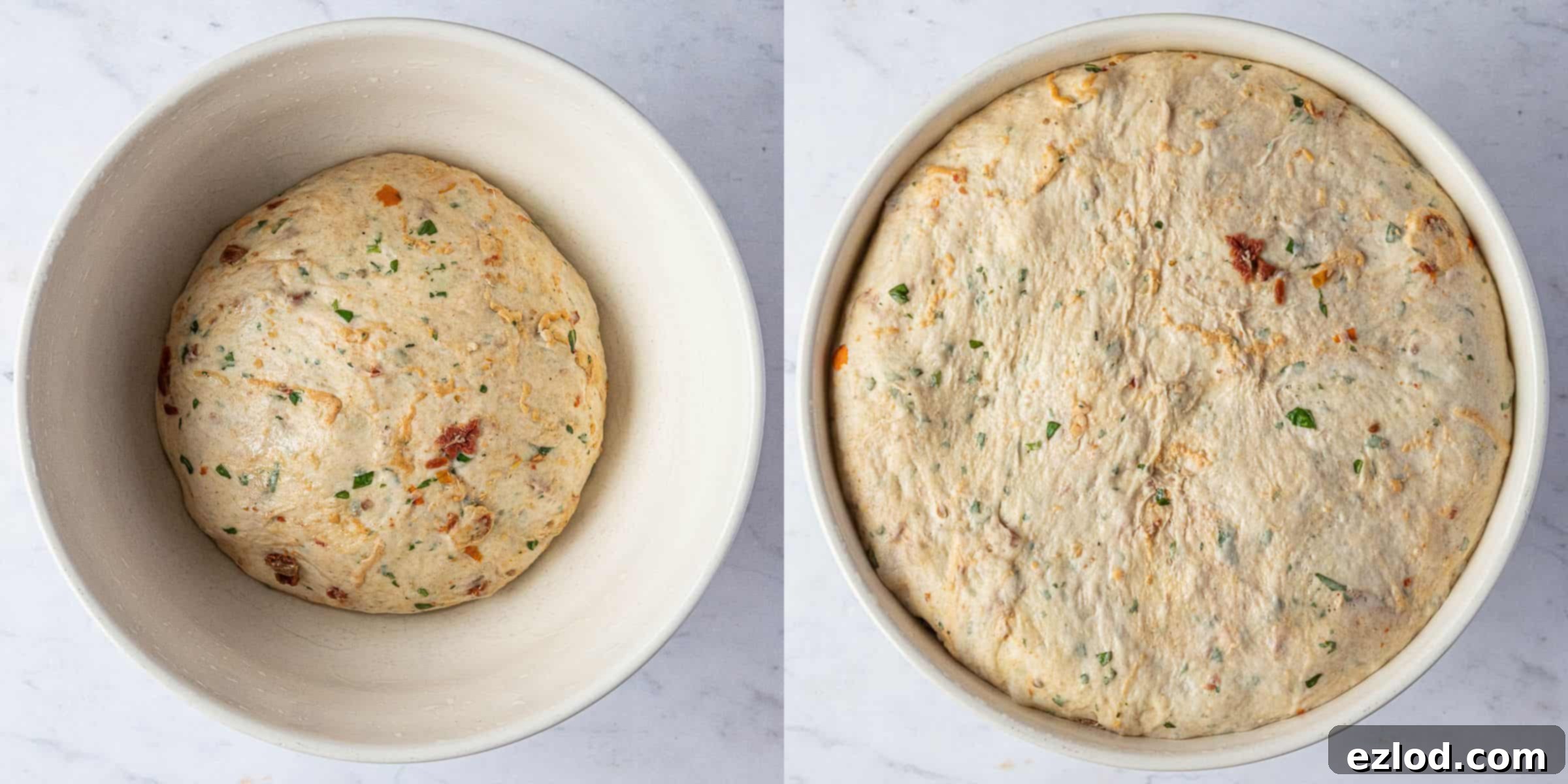
- Deflate, Divide, and Prepare for Shaping: Once the dough has proudly risen and doubled, gently “punch it down” to release the accumulated air. Transfer the dough to a clean, lightly floured surface and give it a brief knead to knock out any remaining large air bubbles. This also helps to redistribute the gluten. Divide the dough into 14 equal pieces. For the most consistent breadstick size and even baking, I highly recommend using a kitchen scale for accuracy when dividing the dough.
- Shape the Breadsticks and Prepare Baking Sheets: Line two large baking sheets with baking parchment. If desired, sprinkle the parchment with a fine, even layer of semolina or cornmeal. This optional step significantly helps prevent sticking and contributes to a wonderfully crisp bottom crust. Take each individual piece of dough and, using your hands, roll it out into a long, thin rope. Aim for a length of approximately 6-8 inches (15-20 cm). Arrange the shaped breadsticks on the prepared baking sheets, ensuring they are spaced adequately apart to allow for expansion during their second rise and baking.
- Second Rise (Proofing): Loosely cover the shaped breadsticks with oiled cling film or another sheet of baking parchment. This prevents them from drying out. Set them aside again in a warm, draft-free spot for about 30 minutes. During this second rise, they should become noticeably puffy and slightly larger. To test if they’re properly proofed and ready for baking, gently poke one with a finger; if it springs back slowly most of the way, they’re good to go. If it springs back immediately, they need more time; if it collapses, they are over-proofed.
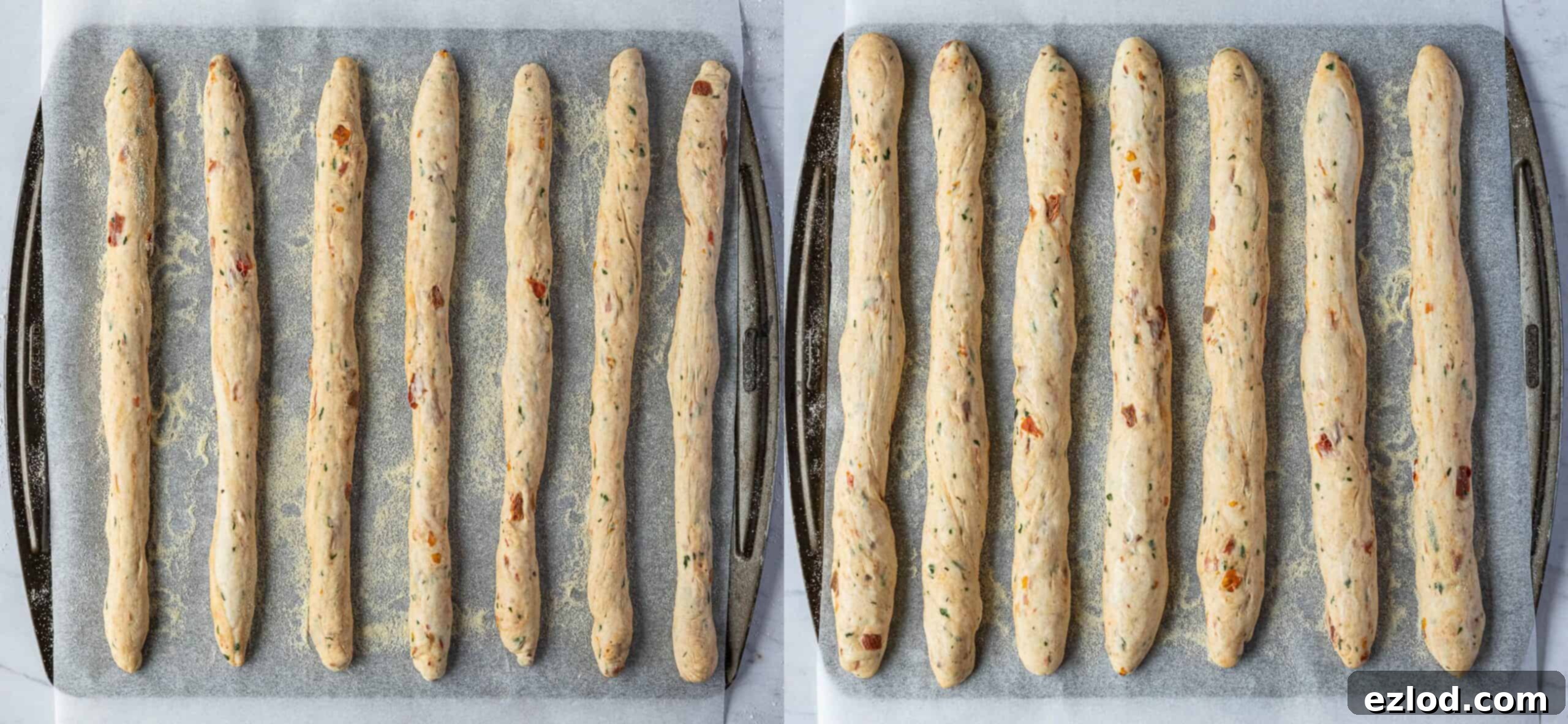
- Preheat Oven and Bake: While the breadsticks are undergoing their second rise, preheat your oven to 220°C/200°C fan/425°F/gas mark 7. Once the breadsticks are adequately proofed, gently brush the tops of each one with a small amount of olive oil. This enhances their flavor and helps achieve that beautiful golden-brown crust. Carefully transfer the baking sheets to the preheated oven. Bake for 12-15 minutes, or until the breadsticks are nicely browned, firm to the touch, and cooked through.
- Cool and Serve: Once baked to perfection, carefully remove the breadsticks from the oven. Transfer them to a wire rack to cool slightly. While they are absolutely delightful served warm, allowing them to cool for a few minutes will help their texture set and intensify their flavor. Serve immediately and prepare to be asked for the recipe!
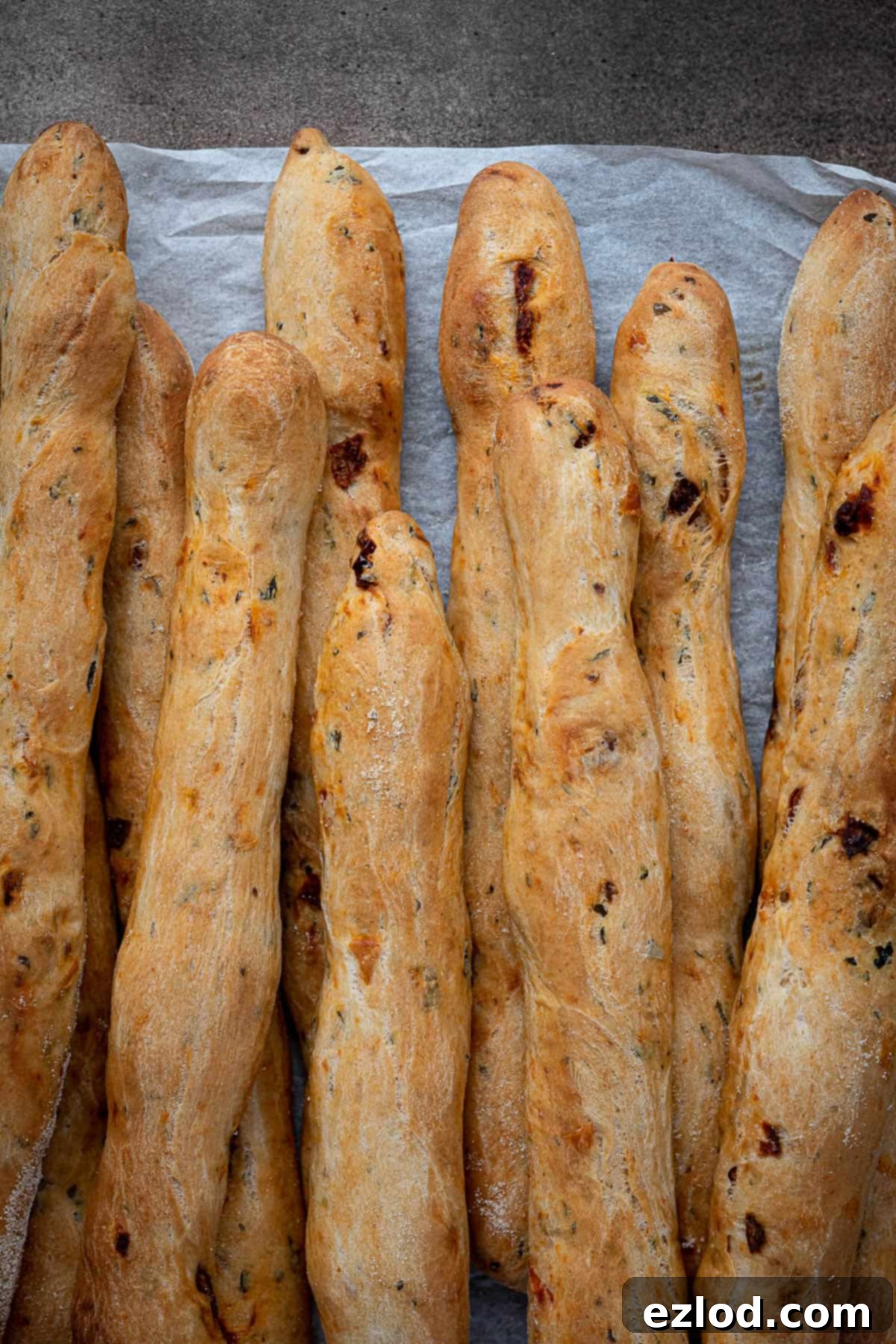
Top Tips for Baking Perfect Homemade Vegan Breadsticks:
Achieving bakery-quality breadsticks at home is simpler than you think with these expert tips and tricks:
- Precision is Key: Embrace Your Digital Scale: All my baking recipes, including these delightful breadsticks, are developed using metric measurements, specifically grams. For consistent and truly superior baking results, I cannot stress enough the importance of using a digital kitchen scale instead of volume-based cup conversions. Cups are notoriously inaccurate and can lead to significant variations in your dough’s hydration and texture, often resulting in disappointing outcomes. A scale ensures precision, making your baking experience easier, less messy, and far more reliable every single time.
- Always Check Your Yeast’s Vitality: Yeast is a living organism, and its potency can diminish significantly over time. Before you even start measuring ingredients, always check the expiry date on your yeast packet. Old or inactive yeast is the primary culprit behind bread that fails to rise adequately or at all. If you’re unsure about its freshness, you can “proof” a small amount (about a teaspoon) in a quarter cup of lukewarm water with a pinch of sugar. If it doesn’t get visibly frothy and bubbly within 5-10 minutes, it’s likely dead and should be replaced with fresh yeast.
- Understand the Impact of Temperature on Rising: The time it takes for your dough to rise is directly influenced by the ambient temperature of your kitchen. On warmer days, the yeast will be more active, and the dough will rise much faster. Conversely, in colder environments, the rising process will be considerably slower. Don’t strictly adhere to the time given in the recipe; instead, watch the dough for visual cues, primarily that it has visibly doubled in size. Trust your eyes over the clock!
- Plan Ahead: The Overnight Rise Option: While these sun-dried tomato breadsticks can certainly be made and enjoyed in a single day, you have the wonderful flexibility to prepare the dough in the evening. After the initial kneading and the incorporation of the sun-dried tomatoes and basil, place the dough (covered tightly with plastic wrap or a lid) in an oiled bowl in the fridge to rise slowly overnight. This slow, cold fermentation not only makes your morning baking less rushed but can also develop a deeper, more complex flavor in the bread. The next morning, simply remove the dough, let it sit at room temperature for 30 minutes to an hour to warm up slightly, then continue with the rest of the recipe as instructed. Be aware that the second rise may take a bit longer as the dough will still be quite cold.
- Best Enjoyed Fresh and Warm: Like most homemade bread products, these vegan sun-dried tomato breadsticks are at their absolute peak of freshness and flavor when eaten on the day they are baked, preferably still slightly warm from the oven. Their texture and aroma are most vibrant at this point.
- Storing Leftovers & Reheating for Freshness: If you happen to have any leftover breadsticks (a rare occurrence!), store them in an airtight container at room temperature for up to 2 days. To refresh them and bring back some of their original crispness and warmth, reheat them briefly in a low oven (around 150°C/300°F) for 5-10 minutes before serving. This revives their texture beautifully.
Understanding Yeast Types: Instant vs. Active Dry
The world of yeast can sometimes seem a little confusing for new bakers, but it’s simpler than you think. Knowing the difference between instant and active dry yeast will make your bread-making much smoother:
- Instant Yeast (or Easy Bake Yeast): This is my preferred type of yeast for its sheer convenience and reliability. Instant yeast granules are smaller and designed to dissolve and activate quickly. This means you can add them directly to your dry ingredients along with the flour, salt, and sugar, without the need for prior activation in liquid. This streamlines the bread-making process considerably, making it perfect for busy bakers or anyone who prefers a more straightforward approach. I highly recommend buying instant yeast if possible.
- Active Dry Yeast: If active dry yeast is the only type you have on hand, you can absolutely still use it to make these delicious breadsticks, but the preparation method will differ slightly. Active dry yeast needs to be “activated” or “proofed” in a warm liquid before being combined with the rest of your ingredients to ensure it’s alive and ready to work. Here’s how to do it:
- You will need 10g (which is about 3 teaspoons) of active dry yeast for this recipe.
- In a small bowl, combine the active dry yeast with the lukewarm water (ensure the water is not hot, as excessive heat will kill the yeast and prevent your dough from rising!) and the single teaspoon of sugar from the recipe. The sugar acts as a food source for the yeast, helping it to activate.
- Stir the mixture gently and let it sit undisturbed for 10-20 minutes. You’ll know the yeast is active and healthy when the mixture becomes visibly frothy, bubbly, and foamy on the surface. This indicates the yeast is alive and ready to leaven your dough.
- Once activated, proceed with the rest of the recipe as written, incorporating this bubbly yeast mixture as your liquid component.
How to Create a Warm Environment for Faster Rising Dough:
If your kitchen is on the cooler side, which can significantly slow down the dough’s rising time, you can easily create a warm, cozy environment to help your dough proof more quickly and efficiently. Here are a couple of effective methods:
- The “Slightly Warmed Oven” Method:
- Preheat your oven to its absolute lowest temperature setting for just a few minutes. You want it to be barely warm, not hot.
- Turn the oven off completely. It’s crucial that the oven is off before the dough goes in.
- Open the oven door for about 30 seconds to allow some of the intense residual heat to escape.
- Carefully test the temperature inside the oven with your hand. It should feel pleasantly warm, similar to a warm summer day, but definitely not hot. An oven that is too hot will kill the delicate yeast, preventing your dough from rising altogether. Be cautious!
- Place your covered dough (in its oiled bowl, covered with plastic wrap or a damp towel) into the lightly warmed oven and gently shut the door. If it’s a particularly cold day, you may need to repeat the warming process once more after an hour or so, but often, one gentle warming is sufficient to kickstart the rise.
- The “Boiling Water & Steam” Method: This method creates a warm and humid environment, which is ideal for dough rising, without any risk of overheating the yeast:
- Place a heat-proof bowl or an empty loaf tin at the very bottom of your (cold and switched-off) oven.
- Place your covered dough (in its oiled bowl) on the middle shelf of the oven.
- Carefully fill the bowl at the bottom with boiling water. The steam will immediately begin to warm and humidify the oven cavity.
- Close the oven door. The consistent warmth and moisture from the steam will create a perfect, draft-free environment for your dough to rise beautifully.
Frequently Asked Questions (FAQs) About Sun-Dried Tomato Breadsticks
Can I Freeze These Sun-Dried Tomato Breadsticks?
Yes, absolutely! These delicious vegan sun-dried tomato breadsticks freeze wonderfully, making them an excellent option for meal prepping, entertaining, or simply enjoying a homemade treat whenever the craving strikes. To best preserve their freshness, flavor, and texture, it’s recommended to freeze them on the same day they are baked. Ensure they have cooled completely to room temperature before freezing. Place them in an airtight container or a heavy-duty ziplock freezer bag to protect them from freezer burn. When you’re ready to enjoy them, allow them to defrost at room temperature for a few hours. For the best possible experience, refresh them in a low oven (around 150°C/300°F) for 5-10 minutes. This quick reheat will bring back their lovely crispness and warmth, making them taste almost as good as freshly baked.
Can I Make Them In Advance?
While these homemade breadsticks are undoubtedly at their absolute peak of freshness, flavor, and texture when eaten warm from the oven on the day they are baked, you can certainly prepare the dough in advance to streamline your baking process. As detailed in the ‘Top Tips’ section above, you have the option to make the dough the evening before you plan to bake. After the initial kneading and the incorporation of the flavorful sun-dried tomatoes and basil, place the covered dough in an oiled bowl and let it undergo a slow rise in the fridge overnight. The next day, simply remove the dough from the refrigerator, allow it to sit at room temperature for approximately 30 minutes to an hour (this helps the dough warm up slightly and become more pliable), and then proceed with shaping, the second rise, and baking exactly as instructed in the recipe. Keep in mind that the second rise might take a little longer than usual due to the dough being cold from the fridge.
Can I Make Them Gluten-Free?
No, I’m afraid that a simple substitution of gluten-free flour for the bread flour in this recipe will not work successfully. Making gluten-free bread is a specialized art and is significantly trickier than baking with traditional wheat flour. The entire recipe structure, including the liquid ratios, the amount and type of leavening agents, and the specific mixing techniques, would need to be completely reformulated to achieve a desirable result with gluten-free flour. As gluten-free baking is not my area of expertise, I cannot advise on specific modifications or guarantee successful outcomes. For delicious gluten-free breadsticks, it is always best and most reliable to seek out a recipe that has been specifically designed, tested, and optimized for gluten-free ingredients, rather than attempting to adapt a traditional wheat-based recipe. Using a purpose-built gluten-free recipe will yield much better results.
More Delicious Vegan Sharing Bread Recipes You’ll Love:
If you loved making and devouring these sun-dried tomato and basil breadsticks, you’re in for a treat! Explore some of my other fantastic vegan bread recipes that are perfect for sharing with friends and family:
- Herby Vegan Breadsticks – The wonderfully versatile base recipe for these tomato and basil delights, perfect for customization.
- Vegan Garlic Dough Balls – Pillowy soft, intensely garlic-infused bites that are impossible to resist.
- Vegan Pretzel Bites – Salty, chewy, and irresistibly dippable – a fun twist on classic pretzels.
- Vegan Garlic Pull Apart Bread – A true crowd-pleaser, this tear-and-share favorite is loaded with garlicky goodness.
- Vegan Pesto Bread Wreath – Beautiful to look at and bursting with vibrant pesto flavor, perfect for entertaining.
- Vegan Beer Pretzels – A unique and savory twist on classic pretzels, with a hint of malty beer flavor.
- Sea Salt and Rosemary Focaccia – A simple yet elegant Italian flatbread, known for its airy texture and aromatic topping.
- Vegan Naan Bread – Soft, fluffy, and perfectly chewy, these naans are ideal for scooping up curries or your favorite dips.
- Easy Flatbreads – Quick to make and incredibly versatile, these are perfect for wraps, dips, or as a side.
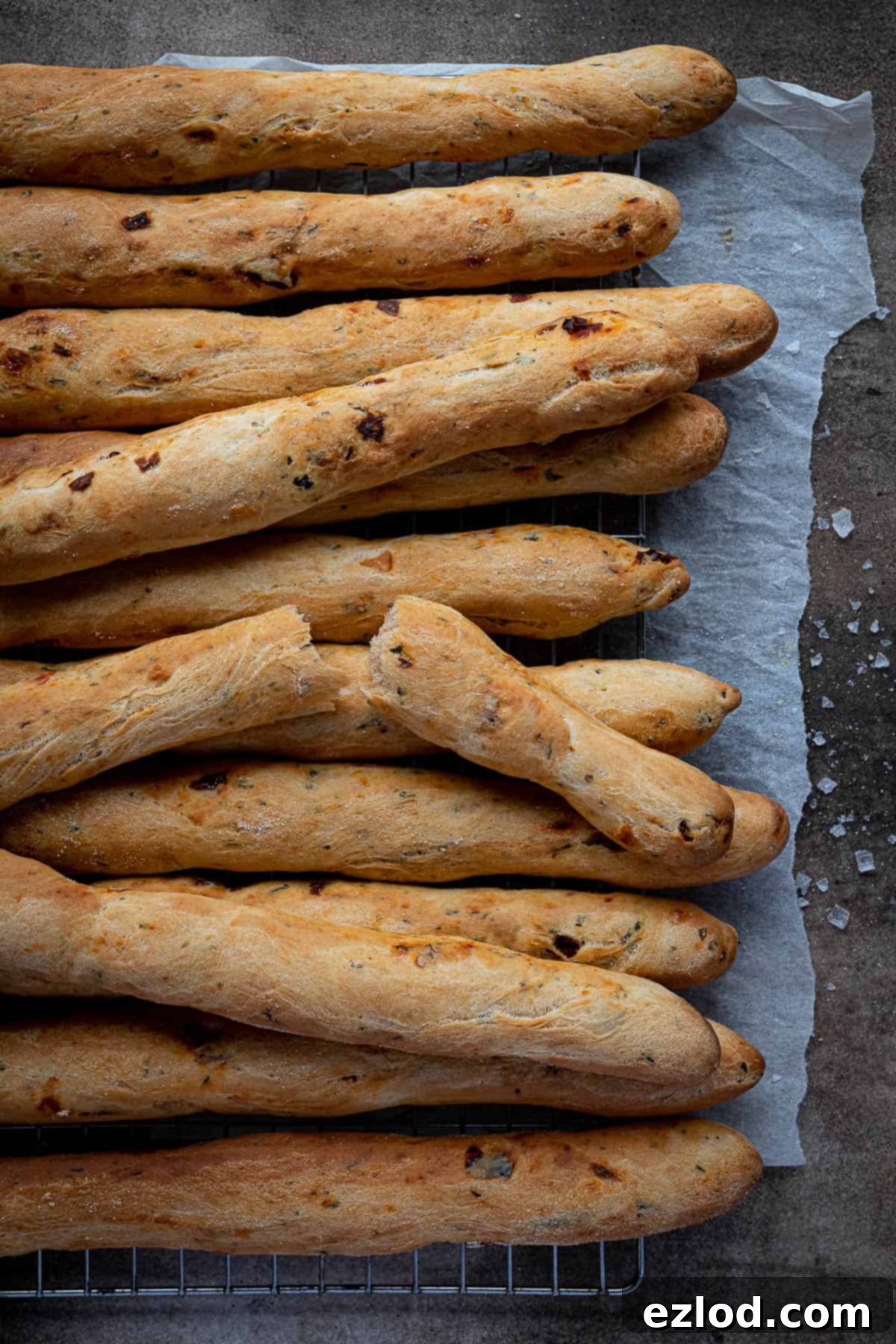
If you’ve had the pleasure of trying this incredibly delicious recipe for vegan sun-dried tomato breadsticks, I would absolutely love to hear about your experience! Please take a moment to rate it, leave a comment below sharing your thoughts and any tips, or share your beautiful creations on Instagram by tagging @domestic_gothess and using the hashtag #domesticgothess. Your feedback and photos are greatly appreciated and help other bakers!
All images and content on Domestic Gothess are copyright protected. If you wish to share this recipe with others, please do so respectfully by utilizing the provided share buttons. Please do not screenshot, copy, or reproduce the recipe or content in full. Instead, we kindly request that you include a direct link to this post for the complete recipe and detailed instructions. Thank you for your understanding and support!

Print
Sun Dried Tomato Breadsticks (Vegan)
Ingredients
- 500 g (4 cups) white bread flour
- 7 g (1 teaspoon) salt
- 1 teaspoon sugar
- 7 g (2 ¼ teaspoons) instant yeast
- 60 ml (¼ cup) olive oil
- 300 ml (1 ¼ cups) lukewarm water
- 100 g (drained weight) sun dried tomatoes (the kind packed in oil)
- 15 g (a big handful) fresh basil (leaves only)
- fine semolina for dusting
- olive oil for brushing
Instructions
-
Place the bread flour in a large bowl (or the bowl of a stand mixer fitted with a dough hook), add the yeast to one side and the salt and sugar to the other. Stir to combine.
-
Pour in the olive oil and water and mix to form a rough dough.
-
Knead, either by hand on an unfloured surface or with the stand mixer on a medium/high speed, for 5-10 minutes until the dough is smooth and elastic. It should be slightly tacky to the touch but should pull away from the sides of the bowl cleanly. If it feels wet then you can add a little more flour but be careful, the dough is meant to be a bit sticky.
-
Thoroughly dry the sun dried tomatoes with kitchen paper then chop them into small pieces. Finely chop the basil.
-
Add the tomatoes and basil to the dough and knead through until they are evenly distributed. Add a little extra flour if needed to counter the extra moisture.
-
Place the dough in an oiled bowl, cover and set aside to rise until doubled in size, about 1-2 hours.
-
Punch down the risen dough and give it a brief knead to knock out any air bubbles. Divide the dough into 14 pieces. I use a scale for accuracy.
-
Line two baking sheets with baking parchment and sprinkle them with fine semolina or cornmeal (optional).
-
Roll each piece of dough out using your hands into a long, thin rope. Place them spaced apart on the baking sheets.
-
Loosely cover with oiled clingfilm or baking parchment and set aside to rise for about 30 minutes until they are puffy and spring back slowly most of the way if you poke one gently with a finger.
-
Meanwhile, preheat the oven to 220°C/200°C fan/425°F/gas mark 7.
-
Gently brush the risen breadsticks with olive oil. Bake for 12-15 minutes until nicely browned. Transfer the baked breadsticks to a wire rack to cool slightly before serving.
Notes
- See post above for tips, details and step-by-step photos.
- All of my recipes are developed using grams, and as with all of my baking recipes I really do recommend using the metric measurements with a digital scale rather than the cup conversions. Cups are a wildly inaccurate measuring system and you will get far better, more consistent results using a scale, not to mention that it is also easier and less messy than cups!
- If kneading the dough by hand then a bench scraper will be very useful.
